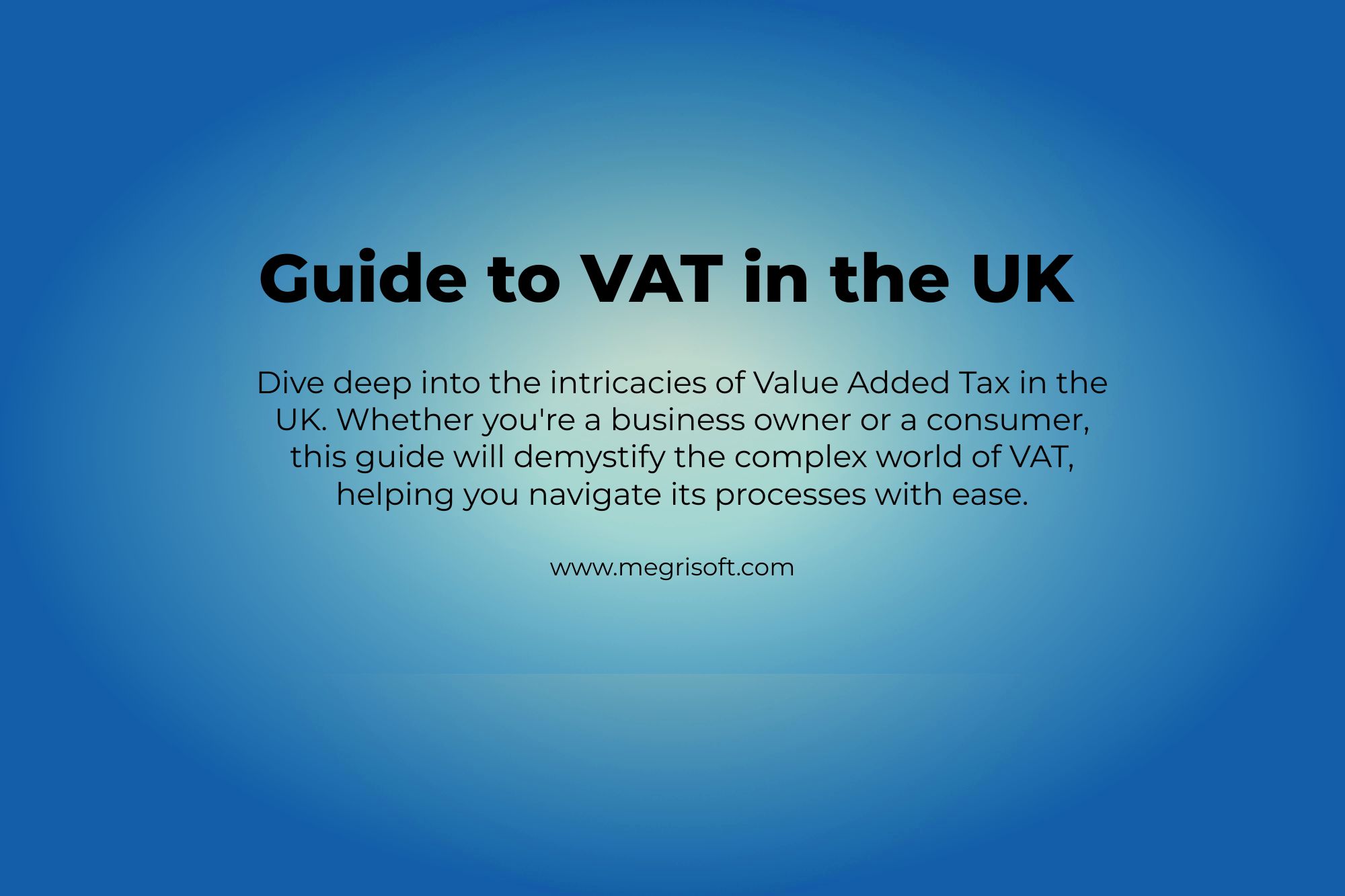
VAT is a complex tax, but it’s important for businesses to understand it. This guide covers everything you need to know about VAT in the UK, from registration to returns to exemptions. Dive deep into the intricacies of Value Added Tax in the UK. Whether you’re a business owner or a consumer, this guide will demystify the complex world of VAT, helping you easily navigate its processes.
On 1 April 2023, VAT celebrated its 50th anniversary in the UK. VAT was introduced in anticipation of the UK’s entry into the European Economic Community (EEC), now known as the European Union (EU). The Value Added Tax (VAT) system has played an important role in the UK tax system since its introduction in 1973. Over the past 50 years, the VAT system has undergone numerous changes, reflecting the UK economy’s and tax system’s ever-changing needs. While VAT has proven to be a reliable source of revenue for the government, it has also been controversial and debated due to its complex nature and frequent updates.
Introduction to VAT in the UK
VAT is a consumption tax that is applied to most goods and services sold in the UK. It is a destination-based tax charged in the country where the goods or services are consumed. VAT is charged at a standard rate of 20%, but there are also reduced rates of 5% and 0% for certain goods and services, such as food, children’s clothing, and public transport.
Value Added Tax, commonly known as VAT, is an integral aspect of the financial landscape in the United Kingdom. It impacts businesses, consumers, and the broader economy.
1.1 Brief History of VAT
The introduction of the Value Added Tax (VAT) in the UK in 1973 marked a significant shift in the country’s taxation system. Before this, the UK had operated with the Purchase Tax, primarily levied on luxury goods. VAT, however, was designed to be a more comprehensive tax system, encompassing a broader range of goods and services.
Origins and the European Influence
The primary impetus for introducing VAT in the UK was its impending entry into the European Economic Community (EEC), now known as the European Union (EU). The EEC required all member states to implement a harmonized value-added taxation system. While the UK was not the first country to adopt VAT – it was already in operation in several European nations – its introduction was seen as crucial for aligning the UK’s fiscal policies with those of its continental neighbours.
Transition from Purchase Tax
The transition from the Purchase Tax to VAT was not merely renaming the existing system. Purchase Tax was levied at varying rates depending on the perceived luxury status of the good, making it somewhat arbitrary and complex. In contrast, VAT aimed to be more uniform and was applied at almost every stage of the production and sales process, providing the government with a steady revenue stream.
Evolving Rates and Rules
Since its introduction, the VAT system in the UK has seen numerous changes. Initially, the standard rate of VAT was set at 10%, but over the decades, this has fluctuated in response to economic pressures, political decisions, and global financial conditions. For instance, during economic downturns, the government sometimes lowered VAT rates to stimulate spending, only to raise them again when fiscal stability was re-established.
In addition to changes in the rate, there have been significant revisions to the rules governing VAT. Exemptions and zero-rated goods, for instance, have been subjects of extensive debate and policy revisions. Items like children’s clothing and most food products, initially outside the VAT net, have remained zero-rated, while other items have seen their status change over time.
1.2 Purpose and Importance of VAT
VAT is a consumption tax, meaning it’s levied on the value added to goods and services. Its primary purpose is to generate revenue for the government. VAT contributes significantly to the national exchequer in the UK, financing essential public services.
Basic Concepts and Definitions
2.1 What is VAT?
VAT stands for Value Added Tax. It’s a general consumption tax applied to the value added to goods and services at each stage of production or distribution.
2.2 How is VAT Different from Sales Tax?
While VAT and sales tax are levied on the end consumer, their collection methods differ. The retailer collects Sales tax when the end consumer purchases a product. In contrast, VAT is collected at each stage of the production or distribution process.
2.3 Different VAT Rates in the UK
There are three main VAT rates in the UK:
- Standard Rate (20%): Applied to most goods and services.
- Reduced Rate (5%): For certain goods and services, like home energy.
- Zero Rate (0%): Items like most foods and children’s clothing.
The standard rate of VAT in the UK is 20%, but there are also reduced rates of 5% and 0%, and some goods and services are exempt from VAT altogether. For example, food, children’s clothing, and books are all zero-rated for VAT, meaning that no VAT is charged to them
Registration and Thresholds
3.1 When to Register for VAT
Businesses must register for VAT if their VAT-taxable turnover exceeds £85,000 (as of the last update). This threshold is reviewed annually by HMRC.
3.2 How to Register
Businesses can register online through the HMRC’s website. Once registered, they’ll receive a VAT Registration Certificate.
3.3 Voluntary Registration and its Benefits
Even if a business doesn’t exceed the threshold, it can register for VAT voluntarily. This can enhance business credibility and allow for reclaiming VAT on purchases.
VAT Calculations and Reporting
4.1 Calculating VAT for Sales and Purchases
Businesses must charge VAT (at the appropriate rate) on their goods/services. They can reclaim VAT paid on business-related goods/services.
4.2 Filling out a VAT Return
Registered businesses must submit a VAT return to HMRC every three months. This document summarizes the VAT owed and reclaimed.
4.3 Deadlines and Penalties
VAT returns should be submitted, and any VAT owed should be paid within one month and seven days after the end of the VAT period. Late submissions or payments can lead to penalties.
Special VAT Schemes
5.1 Flat Rate Scheme
This is for small businesses with a VAT-inclusive turnover of £150,000 or less. They pay a fixed percentage of their turnover as VAT and keep the difference between what they charge customers and what they pay HMRC.
5.2 Retail Schemes
For retailers who find it impractical to issue invoices for each sale. There are different types: Point of Sale, Apportionment, and Direct Calculation.
5.3 Margin Schemes
For businesses dealing in second-hand goods, art, antiques, and collectables. They can pay VAT on the difference (or margin) between the purchase and selling price.
Claiming VAT Back
6.1 Eligible Expenses for VAT Refund
You can reclaim VAT on most purchases your business makes, like stock or equipment, advertising or marketing, employee wages, and building maintenance.
6.2 Process for Claiming Back VAT
Claims are typically made through your regular VAT return. It’s essential to have valid VAT invoices for all claims.
International Transactions and VAT
7.1 Importing Goods and VAT
VAT is generally payable on imported goods. The rate depends on the type of goods and their origin.
7.2 Exporting Goods and VAT
Goods exported outside the UK are usually zero-rated for VAT. However, businesses must keep evidence of exports.
7.3 Digital Services and VAT for Non-UK Businesses
Since 2015, the “place of supply” for digital services to consumers is where the consumer resides. Hence, non-UK businesses supplying digital services to UK consumers must register and account for UK VAT.
Common Mistakes and How to Avoid Them
8.1 Incorrect VAT Rate Application
Always ensure you’re applying the correct VAT rate. Regularly check the HMRC website for rate updates.
8.2 Missing Deadlines
Keep a calendar or set reminders for VAT return deadlines to avoid late penalties.
8.3 Incorrect Record Keeping
Maintain thorough and accurate records of all transactions. Use accounting software or hire professionals if needed.
Future of VAT in the UK: Predictions and Trends
9.1 Brexit and its Impact on VAT
Post-Brexit, the UK isn’t bound by EU VAT directives. This could lead to changes in VAT rates and rules.
9.2 Technology and VAT Automation
With technological advances, businesses automate VAT calculations and submissions, making the process more accurate and efficient.
The Future Direction of VAT in the UK
Anticipating the trajectory of VAT in the UK, various elements stand poised to influence its evolution.
Authorities might contemplate adjusting VAT rates as a strategy to boost the economy, bridge the wealth gap, or confront ecological issues.
Emerging technologies, notably blockchain and the swift expansion of artificial intelligence (AI), have the potential to transform the way VAT is managed and regulated. Moreover, there’s potential for VAT to integrate with green initiatives, like carbon taxes, in the foreseeable future.
Facts and Insight of VAT in the UK
- VAT is the UK’s second-largest source of revenue after income tax. In 2022-23, VAT is expected to raise £139.5 billion for the government.
- VAT is the UK’s third-largest source of tax revenue, after income tax and National Insurance. In the 2022-23 tax year, VAT is expected to raise £134.8 billion.
- Businesses must register for VAT if their taxable turnover exceeds £85,000. They can also choose to register if their turnover is less than £85,000.
- VAT is a consumption tax, meaning the final consumer ultimately bears it. Businesses collect VAT from their customers and then pass it on to the government.
- Over 2 million businesses are registered for VAT in the UK.
- The average VAT liability for a registered business in the UK is £10,000 per year.
Conclusion and Resources
10.1 Additional Reading and Guidance
For more in-depth knowledge, consider consulting HMRC’s official publications or seeking advice from VAT specialists.
10.2 Contacting HMRC for VAT Queries
For specific issues or clarifications, you can contact HMRC’s VAT helpline.
VAT is the third-biggest source of government revenue in the UK, after income tax and National Insurance contributions. In 2021-22, VAT raised £143 billion for the government.
Navigating the world of VAT in the UK can be challenging. However, with the right information and understanding, it becomes more manageable. This guide is a starting point for anyone seeking clarity on the topic.

Comments are closed.